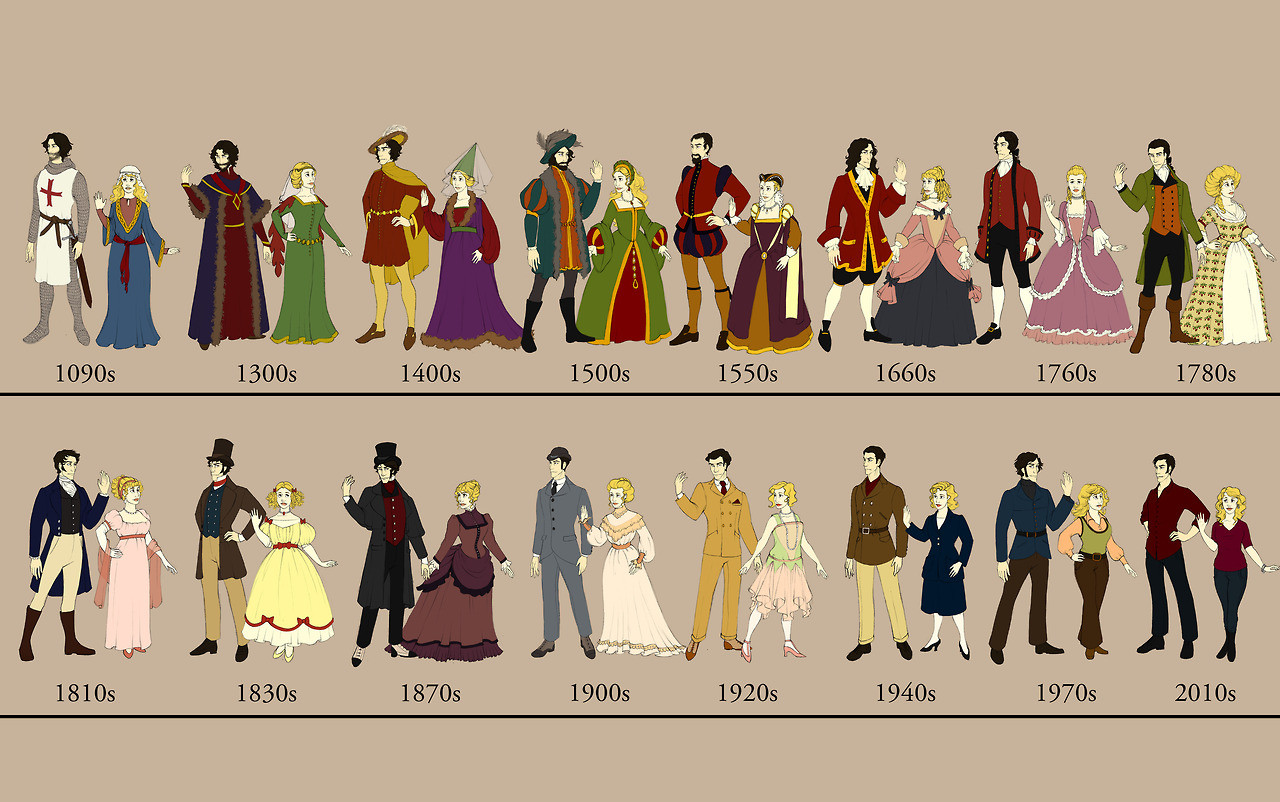Throughout history, fashion has been hugely important.
Often it’s been a sign of one’s status or wealth and many laws have been passed to limit what can be worn depending on your social class.
Some of the fashions have had a slightly more practical use – for example various shoes were designed for women to wear so that they could not move very far and engage in extra-marital affairs!
Some clothes were designed to show that the wearer could not possibly have done any physical work, which showed their status.
If your sleeves were floor length, or your shoes so high you couldn’t walk without assistance, then obviously you needed servants to help you with the most basic of tasks. But when we talk about a fashion victim nowadays, we usually mean someone who must have the latest thing – not a more literal victim.
Yet in the past, fashion has caused deaths, diseases and many accidents.
Footwear has a very long history of strange fashions.
Essentially the purpose of a shoe is to allow you to walk long distances in comfort and safety, and preferably to keep your feet dry too, but surprisingly few have achieved these simple jobs.
As with most fashion, it was the upper classes who went for the more extreme types of footwear, as the less wealthy couldn’t afford it.
We have seen shoes for example that were so long that the wearer would trip over the toes, and a law had to be passed to limit the length of the shoe to 2 inches past the toes.
Before that, these long extra toes needed to be padded, and were often tied up to just below the knee so that the wearer could move at all without breaking their neck.
The Church objected to them too, as kneeling to pray was almost impossible. As with many fashions, new trends would often start with the monarchy, and the shoe design would mask some foot deformity, so that the very wide shoe of the Tudor period was popularised by Henry VIII who had very wide feet due to gout.
A law was passed to limit the width of the shoe to six inches, which once again probably avoided accidents as people tripped over their extra wide feet. There is some disagreement about who first came up with the very pointed shoe, but it was probably French in origin, and crushed the toes narrowly together, making walking difficult for everyone with a usual width of foot.
The very high heel has various origins. Pattens were wooden overshoes worn in China and Japan to allow a lady to cross a muddy street without endangering her beautiful silk slippers.
The patten, which was a sort of wooden block which raised the foot above the mud, would then be removed. If she was aristocratic, her feet would have been bound from birth, meaning that her feet would be about three inches in length, and unable to walk without assistance. These were called “golden lily’ feet, and involved binding the toes underneath the foot, until they eventually fell off, creating permanent disability.
To have a wife with “golden lilies’ was a sign of economic status, and they would be closely examined by prospective in-laws.
The practice continued until the end of the Nineteenth century, and Chinese women came to England to show them off at exhibitions.
Apart from the agony of the process, foot-binding resulted in deaths from gangrene, and in amputations too.
In Europe, the chopine was worn instead, a similar item to the patten, and with the same purpose in mind – to keep the shoe out of the grime of the streets.
But like many such things it became exaggerated and the chopine became higher and higher – up to 30 inches tall!
Even at the time they were laughed at (Shakespeare commented on them) but they lingered as a fashion for some time. As can be imagined, actually walking safely in them was almost impossible.
But the true high-heel seems to have originated in France when the Sun King introduced them to disguise his rather short stature.
Of course, high heels are still worn today, and they still have their dangers, but nothing like those of the originals.
The lady would literally be standing on tip-toe, so high was the heel.
Then the platform was added, to increase the height still further and these reached such absurd heights that a law had to be passed to limit their height, as so many women were tripping and falling to their deaths.
Congratulations are due to the man who, in 1818, made different shoes for left and right feet, which made everyone much more comfortable.
Prior to that, a pair of shoes would simply be two identical shoes.
We would think we’d learn by our mistakes, but no.
The 1950’s saw some extreme examples of shoes, with very pointed toes, and high stiletto heels which compressed the toes by throwing the foot forwards.
Stiletto heels could and did get caught in gratings, throwing the wearer. But possibly one of the oddest fashions which is apparently due for a come-back, is the heelless or cantilever shoe, which has no heel at all, but is still high.
To walk in these it is necessary to walk on tip-toe, and not lean back.
It’s possible that our love of fashion when it comes to shoes is their statement of status.
The very poor always went barefoot. And to be barefoot was a sign of humility which most religions embraced. Shoes were a sign of wealth and status, and the more impractical they were, the higher your status must be.
Hair has also always been associated with wealth and status, particularly with women. Some religions insist that all the hair is cut off, as hair was seen as alluring, and very obvious wigs were worn instead.
Some religions insist that hair is never cut at all. Many religions and cultures insist that hair be covered, as free or unbound hair was seen as a temptation to men.
Hair has assumed an important role in beauty and to have it cut off was a sign of shame and a punishment for crimes throughout history.
Long hair has until recently been seen as the ideal, and hair extensions are not a new idea. The very poor could sell their hair to be used to make extravagant wigs for the very wealthy and during the 18th century in particular these reached ridiculous proportions, being up to 2 feet tall. It took many hours work by many servants to attach these wigs and the lady would usually sleep in them, rather than have them removed again, so that after a few weeks of sleeping with a box over her head to avoid disturbing the wig, it would be literally crawling with vermin. Mice nests were not uncommon and it’s said that even birds would nest in the huge filthy structure.
Getting through doors must have been an interesting manoeuvre too. Men also wore wigs at that time, but these were usually smaller affairs and easier to take on and off.
In fact wigs are still worn today in the legal profession.
But apart from making the head itch, and being bitten by various insects, wigs in themselves were not dangerous.
However hair fashion has caused death. Long hair is dangerous if the owner is using machinery in factories, as it can get caught in the machine.
During World War Two many women copied the hair style of a famous Hollywood actress, and of course this was when many women were also doing factory war work.
There were so many serious accidents that the actress was persuaded to alter her hair style so that ordinary women would emulate it, and reduce the number of accidents at work!
Another, more insidious method by which hair fashion may have hastened many deaths is hair dye.
Many of the chemicals used in 20th century hair dyes are now known to contribute to serious forms of cancer.
Historical Note
One rather odd way in which following fashion might kill you was the fact that it was once conceived to be a form of witchcraft!
This is part of a Bill from the British Parliament in 1690:
“Be it resolved that all women, of whatever age, rank, profession, or degree; whether virgin maids or widows; that shall after the passing of this Act, impose upon and betray into matrimony any of His Majesty’s male subjects, by scents, paints, cosmetics, washes, artificial teeth, false hair, Spanish wool, iron stays, hoops, high-heeled shoes, or bolstered hips, shall incur the penalty of the laws now in force against witchcraft, sorcery, and such like misdemeanours, and that the marriage, upon conviction, shall stand null and void.


